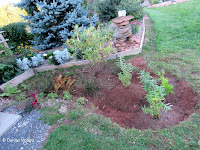GROWING MILKWEED
MILKWEED can adapt to various growing conditions. However if you want to attract Monarch butterflies, which are a field species, your plants should ideally be located in an open space not too close to buildings or trees or tall shrubs.
The photos below provide some examples of good and not-so-good locations to plant milkweed. It’s not always easy to anticipate the amount of space a tree or shrub will eventually need, and the shade it will project, when planting them as a young sapling.
SWAMP MILKWEED – Native to eastern Canada and most of the USA, this species does NOT need a swamp (as its name suggests) to grow successfully. All it needs is a reasonably moist ground in a shallower area, with some mulch to keep moisture.
This species does not spread from its roots, as they form a clump but no rhizomes. The clump gets a bit larger every year. The plant spreads from its seeds, which are attached to a silky parachute. To prevent spreading, simply deadhead the seed pods. It is not a dominant plant in its native environment, i.e. can be overcrowded by plants with more invasive habits.
If you plant the seeds in the spring, they will benefit from stratification, i.e. keeping them in a cool place (like a refrigerator) for the winter. Cover them lightly when planting. This is a late-coming perennial in the spring, as late as the beginning of June. Young clumps may be easily transplanted. Flower clusters are generally pink, sometimes white, mature plant about one meter high.
BUTTERFLY MILKWEED – Native to Ontario and Quebec for Canada, and east and south USA. This species does well in well-drained, dry soils such as fields, roadsides and prairies.
This species does NOT spread from its roots as it has a long woody tap root, which makes it VERY difficult to successfully transplant once mature. New stem buds emerge from under the ground, not at the ground level. Spreads from its seeds, which are attached to a silky parachute. To prevent spreading, deadhead the seed pods.
Same instructions for seed planting as for Swamp milkweed. VERY slow to appear in the spring, generally at the beginning of June. The plant is shorter than swamp milkweed, and the flower clusters are generally orange, sometimes yellow.
 |
| Swamp milkweed in 2012 |
 |
| Same plant now overshadowed by Forsythia shrub (2018) |
 |
| Squeezed Butterfly milkweed |
 |
| Butterfly milkweed in sunny spot |
 |
| Butterfly milkweed in 2009 |
 |
| The same spot 9 years later |
 |
| Too close to tree |
 |
| Mini rain garden for Swamp milkweed |
 |
| Rain garden without water |
 |
These Swamp milkweed plants are in a sunny and lower area (to retain moisture longer), and the soil will get a good layer of mulch too.